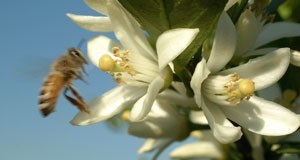Abstract
Nosema are single-celled fungal parasites that infect various animal hosts. One species, Nosema ceranae, has become the dominant microsporidian infection in western honey bee colonies. When honey bees ingest Nosema spores, many eventually starve to death because the spores replicate in the stomach and hijack the bee’s nutrition. The risk of Nosema infection can be particularly unsettling to beekeepers because colonies often do not show signs of infection until the colony is severely diminished. This 5-page fact sheet explains how to diagnose and quantify Nosema infection in a honey bee colony. Written by Ashley N. Mortensen, Cameron J. Jack, Meghan McConnell, Liana Teigen, and Jamie Ellis, and published by the Department of Entomology and Nematology, May 2016.
ENY-167/IN1123: How to Quantify Nosema Spores Infection Rate in a Honey Bee Colony (ufl.edu)
References
Chen, Y, J. D. Evans, L. Zhou, H. Boncristiani, K. Kimura, T-G. Xiao, et al. 2009. "Asymmetrical coexistence of Nosema ceranae and Nosema apis in honeybees." J Invertebr Pathol. 101: 204-209. doi: http://dx.doi.org/10.1016/j.jip.2009.05.012 https://doi.org/10.1016/j.jip.2009.05.012
Fleming JC, Schmehl DR, Ellis JD. 2015. "Characterizing the impact of commercial pollen substitute diets on the level of Nosema spp. in honey bees (Apis mellifera L)." PLoS ONE 10(7): e0132014. doi: http://dx.doi.org/10.1371/journal.pone.0132014 https://doi.org/10.1371/journal.pone.0132014
Fries I. 2010. "Nosema ceranae in European honey bees (Apis mellifera)." J Invertebr Pathol. 103: S73-S79. doi: 10.1016/j.jip.2009.06.017 https://doi.org/10.1016/j.jip.2009.06.017
Fries I, Chauzat M-P, Chen Y-P, Doublet V, Genersch E, Gisder S, et al. 2013. Standard methods for Nosema research. In V Dietemann; J D Ellis, P Neumann (Eds) The COLOSS BEEBOOK: Volume II: Standard methods for Apis mellifera pest and pathogen research. J Apic Res 51(5). doi: 10.3896/IBRA.1.52.1.14 https://doi.org/10.3896/IBRA.1.52.1.14
Human H. Brodschneider R, Dietemann V, Dively G, Ellis J, Forsgren E, et al. (2013). Miscellaneous standard methods for Apis mellifera research. In V Dietemann; J D Ellis; P Neumann (Eds) The COLOSS BEEBOOK, Volume I: standard methods for Apis mellifera research. J Apic Res 52(4). doi: http://dx.doi.org/10.3896/IBRA.1.52.4.10 https://doi.org/10.3896/IBRA.1.52.4.10
Mayack C, Naug D. 2009. "Energetic stress in the honeybee Apis mellifera from Nosema ceranae infection." J Invertebr Pathol. 100: 185-188. doi: 10.1016/j.jip.2008.12.001 https://doi.org/10.1016/j.jip.2008.12.001
Mortensen AN, Schmehl DR, Ellis JD. 2013. Apis mellifera Linnaeus, and subspecies (Insecta: Hymenoptera: Apidae). EENY 568. Gainesville: University of Florida Institute of Food and Agricultural Sciences. http://entnemdept.ufl.edu/creatures/MISC/BEES/euro_honey_bee.htm (March 2019)
Zheng HQ, Lin ZG, Huang SK, Sohr A, Chen YP. 2014. "Spore loads may not be used alone as a direct indicator of the severity of Nosema ceranae infection in honey bees Apis mellifera (Hymenoptera: Apidae)." J Econ Entomol. 107(6): 2037-2044. doi: 10.1603/EC13520 https://doi.org/10.1603/EC13520

